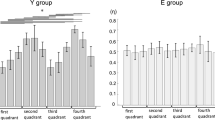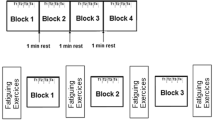Abstract
We studied the effects of fatigue of ankle dorsiflexors on multi-muscle synergies defined as co-varied adjustments of elemental variables (M-modes) that stabilize a task-related performance variable (trajectory of the center of pressure, COP). M-modes were defined as muscle groups with parallel changes in activation levels. Healthy participants performed voluntary body sway in the anterior-posterior direction while trying to minimize sway in the medio-lateral direction at 0.25, 0.5, and 0.75 Hz. The trials were repeated before and during fatigue induced with a timed voluntary contraction against a constant load. Factor extraction using the principal component method was used to identify four M-modes within the space of integrated indices of muscle activity. Variance in the M-mode space at different phases across sway cycles was partitioned into two components, one that did not affect the average value of COP shift and the other that did. There were no significant effects of fatigue on variability of performance of the explicit task and on the amplitude of the COP shift. Variance of muscle activation indices and M-mode magnitudes increased during fatigue for muscles (and M-modes) both involved and not involved in the fatiguing exercise. Most of the M-mode variance increase was within the sub-space compatible with the unchanged COP trajectory resulting in an increase of the index of the multi-M-mode synergy. We conclude that one of the adaptive mechanisms to fatigue within a redundant multi-muscle system involves an increase in the variance of activation of non-fatigued muscles with a simultaneous increase in co-variation among muscle activations. The findings can be interpreted within the referent configuration hypothesis on the control of whole-body actions.










Similar content being viewed by others
References
Asaka T, Wang Y, Fukushima J, Latash ML (2008) Learning effects on muscle modes and multi-mode postural synergies. Exp Brain Res 184:323–338
Babinski J (1899) De l’asynergie cérébelleuse. Rev Neurol 7:806–816
Belaid D, Rougier P, Lamotte D, Cantaloube S, Duchamp J, Dierick F (2007) Clinical and posturographic comparison of patients with recent total hip arthroplasty. Rev Chir Orthop Reparatrice Appar Mot 93:171–180
Bernstein NA (1947) On the construction of movements. Medgiz, Moscow
Bernstein NA (1967) The co-ordination and regulation of movements. Pergamon Press, Oxford
Bisson EJ, McEwen D, Lajoie Y, Bilodeau M (2011) Effects of ankle and hip muscle fatigue on postural sway and attentional demands during unipedal stance. Gait Posture 33:83–87
Caron O (2003) Effects of local fatigue of the lower limbs on postural control and postural stability in standing posture. Neurosci Lett 340:83–86
Carpenter MG, Murnaghan CD, Inglis JT (2010) Shifting the balance: evidence of an exploratory role for postural sway. Neuroscience 171:196–204
Cifrek M, Medved V, Tonkovic S, Ostojic S (2009) Surface EMG based muscle fatigue evaluation in biomechanics. Clin Biomech 24:327–340
Côté JN, Mathieu PA, Levin MF, Feldman AG (2002) Movement reorganization to compensate for fatigue during sawing. Exp Brain Res 146:394–398
Côté JN, Feldman AG, Mathieu PA, Levin MF (2008) Effects of fatigue on intermuscular coordination during repetitive hammering. Mot Control 12:79–92
Danna-dos-Santos A, Slomka K, Zatsiorsky VM, Latash ML (2007) Muscle modes and synergies during voluntary body sway. Exp Brain Res 179:533–550
Danna-dos-Santos A, Degani AM, Latash ML (2008) Flexible muscle modes and synergies in challenging whole-body tasks. Exp Brain Res 189:171–187
Danna-dos-Santos A, Poston B, Jesunathadas M, Bobich LR, Hamm TM, Santello M (2010) The influence of fatigue on hand muscle coordination and EMG–EMG coherence during three-digit grasping. J Neurophysiol 104:3576–3587
d’Avella A, Saltiel P, Bizzi E (2003) Combinations of muscle synergies in the construction of a natural motor behavior. Nat Neurosci 6:300–308
Enoka RM, Duchateau J (2008) Muscle fatigue: what, why and how it influences muscle function. J Physiol 586:11–23
Enoka RM, Baudry S, Rudroff T, Farina D, Klass M, Duchateau J (2011) Unraveling the neurophysiology of muscle fatigue. J Electromyogr Kines 21:208–219
Feldman AG (1966) Functional tuning of nervous system with control of movement or maintenance of a steady posture. II. Controllable parameters of the muscles. Biophysics 11:565–578
Feldman AG (1986) Once more on the equilibrium-point hypothesis (lambda model) for motor control. J Mot Behav 18:17–54
Feldman AG (2011) Equilibrium-point theory. WIREs Cogn Sci 2:287–304
Feldman AG, Latash ML (2005) Testing hypotheses and the advancement of science: recent attempts to falsify the equilibrium-point hypothesis. Exp Brain Res 161:91–103
Feldman AG, Levin MF (1995) The origin and use of positional frames of reference in motor control. Behav Brain Sci 18:723–806
Forestier N, Nougier V (1998) The effects of muscular fatigue on the coordination of a multijoint movement in human. Neurosci Lett 252:187–190
Freeman GL (1933) The facilitative and inhibitory effects of muscular tension upon performance. Am J Psychol 45:17–52
Friedman J, SKM V, Zatsiorsky VM, Latash ML (2009) The sources of two components of variance: An example of multifinger cyclic force production tasks at different frequencies. Exp Brain Res 196:263–277
Fuller JR, Lomond KV, Fung J, Côté JN (2009) Posture-movement changes following repetitive motion-induced shoulder muscle fatigue. J Electromyogr Kines 19:1043–1052
Gates DH, Dingwell JB (2008) The effects of neuromuscular fatigue on task performance during repetitive goal-directed movements. Exp Brain Res 187:573–585
Harris CM, Wolpert DM (1998) Signal-dependent noise determines motor planning. Nature 394:780–784
Huffenus AF, Amarantini D, Forestier N (2006) Effects of distal and proximal arm muscles fatigue on multi-joint movement organization. Exp Brain Res 170:438–447
Ivanenko YP, Cappellini G, Dominici N, Poppele RE, Lacquaniti F (2005) Coordination of locomotion with voluntary movements in humans. J Neurosci 25:7238–7253
Ivanenko YP, Wright WG, Gurfinkel VS, Horak F, Cordo PF (2006) Interaction of involuntary post-contraction activity with locomotor movements. Exp Brain Res 169:255–260
Johnson RA, Wichern DW (1982) Applied multivariate statistical analysis. Prentice-Hall, Englewood Cliffs
Jones KE, Hamilton AFC, Wolpert DM (2002) Sources of signal-dependent noise during isometric force production. J Neurophysiol 88:1533–1544
Kaiser HF (1959) Computer program for varimax rotation in factor analysis. Educ Psychol Meas 19:413–420
Kaiser HF (1960) The application of electronic computers to factor analysis. Educ Psychol Meas 20:141–151
Kanekar N, Santos MJ, Aruin AS (2008) Anticipatory postural control following fatigue of postural and focal muscles. Clin Neurophys 119:2304–2313
Kattla S, Lowery MM (2010) Fatigue related changes in electromyographic coherence between synergistic hand muscles. Exp Brain Res 202:89–99
Klous M, Danna-dos-Santos A, Latash ML (2010) Multi-muscle synergies in a dual postural task: evidence for the principle of superposition. Exp Brain Res 202:457–471
Klous M, Mikulic P, Latash ML (2011) Two aspects of feed-forward postural control: anticipatory postural adjustments and anticipatory synergy adjustments. J Neurophysiol 105:2275–2288
Krishnamoorthy V, Goodman S, Zatsiorsky V, Latash ML (2003a) Muscle synergies during shifts of the center of pressure by standing persons: identification of muscle modes. Biol Cybern 89:152–161
Krishnamoorthy V, Latash ML, Scholz JP, Zatsiorsky VM (2003b) Muscle synergies during shifts of the center of pressure by standing persons. Exp Brain Res 152:281–292
Krishnamoorthy V, Latash ML, Scholz JP, Zatsiorsky VM (2004) Muscle modes during shifts of the center of pressure by standing persons: effects of instability and additional support. Exp Brain Res 157:18–31
Krishnan V, Aruin AS, Latash ML (2011) Two stages and three components of postural preparation to action. Exp Brain Res 212:47–63
Latash ML (1992) Virtual trajectories, joint stiffness, and changes in the limb natural frequency during single-joint oscillatory movements. Neuroscience 49:209–220
Latash ML (2010) Motor synergies and the equilibrium-point hypothesis. Mot Control 14:294–322
Latash ML, Zatsiorsky VM (1993) Joint stiffness: Myth or reality? Hum Mov Sci 12:653–692
Latash ML, Shim JK, Smilga AV, Zatsiorsky VM (2005) A central back-coupling hypothesis on the organization of motor synergies: a physical metaphor and a neural model. Biol Cybern 92:186–191
Latash ML, Scholz JP, Schöner G (2007) Toward a new theory of motor control. Mot Control 11:276–308
Lorist MM, Klein M, Nieuwenhuis S, De Jong R, Mulder G, Meijman TF (2000) Mental fatigue and task control: planning and preparation. Psychophysiology 37:614–625
Lorist MM, Kernell D, Meijman TF, Zijdewind I (2002) Motor fatigue and cognitive task performance in humans. J Physiol 545:313–319
Madeleine P, Madsen TMT (2009) Changes in the amount and structure of motor variability during a deboning process are associated with work experience and neck–shoulder discomfort. Appl Ergonomics 40:887–894
Madeleine P, Voigt M, Mathiassen SE (2008) The size of cycle-to-cycle variability in biomechanical exposure among butchers performing a standardised cutting task. Ergonomics 51:1078–1095
Martin V, Scholz JP, Schöner G (2009) Redundancy, self-motion, and motor control. Neural Comput 21:1371–1414
Missenard O, Mottet D, Perrey S (2008a) The role of cocontraction in the impairment of movement accuracy with fatigue. Exp Brain Res 185:151–156
Missenard O, Mottet D, Perrey S (2008b) Muscular fatigue increases signal-dependent noise during isometric force production. Neurosci Lett 437:154–157
Morris SL, Allison GT (2006) Effects of abdominal muscle fatigue on anticipatory postural adjustments associated with arm raising. Gait Posture 24:342–348
Nardone A, Tarantola J, Giordano A, Schieppati M (1997) Fatigue effects on body balance. Electroencephalog Clin Neurophysiol 105:309–320
Nigg BM, Herzog W (1994) Biomechanics of the musculo-skeletal system. Wiley, New York
Pinsault N, Vuillerme N (2010) Degradation of cervical joint position sense following muscular fatigue in humans. Spine 35:294–297
Robert T, Zatsiorsky VM, Latash ML (2008) Multi-muscle synergies in an unusual postural task: quick shear force production. Exp Brain Res 187:237–253
Scholz JP, Schöner G (1999) The uncontrolled manifold concept: identifying control variables for a functional task. Exp Brain Res 126:289–306
Shapkova EY, Shapkova AL, Goodman SR, Zatsiorsky VM, Latash ML (2008) Do synergies decrease force variability? A study of single-finger and multi-finger force production. Exp Brain Res 188:411–425
Singh T, SKM V, Zatsiorsky VM, Latash ML (2010a) Adaptive increase in force variance during fatigue in tasks with low redundancy. Neurosci Lett 485:201–207
Singh T, SKM V, Zatsiorsky VM, Latash ML (2010b) Fatigue and motor redundancy: adaptive increase in finger force variance in multi-finger tasks. J Neurophysiol 103:2990–3000
Strang AJ, Berg WP, Hieronymus M (2009) Fatigue-induced early onset of anticipatory postural adjustments in non-fatigued muscles: support for a centrally mediated adaptation. Exp Brain Res 197:245–254
Ting LH, Macpherson JM (2005) A limited set of muscle synergies for force control during a postural task. J Neurophysiol 93:609–613
Ting LH, McKay JL (2007) Neuromechanics of muscle synergies for posture and movement. Curr Opin Neurobiol 17:622–628
Todorov E, Jordan MI (2002) Optimal feedback control as a theory of motor coordination. Nat Neurosci 5:1226–1235
Torres-Oviedo G, Ting LH (2007) Muscle synergies characterizing human postural responses. J Neurophysiol 98:2144–2156
Torres-Oviedo G, Macpherson JM, Ting LH (2006) Muscle synergy organization is robust across a variety of postural perturbations. J Neurophysiol 96:1530–1546
Treffner PJ, Turvey MT (1993) Resonance constraints on rhythmic movement. J Exp Psychol 19:1221–1237
Tresch MC, Jarc A (2009) The case for and against muscle synergies. Curr Opin Neurobiol 19:601–607
Vallejo G, Ato M, Valdés T (2008) Consequences of misspecifying the error covariance structure in linear mixed models for longitudinal data. Methodology 4:10–21
Vuillerme N, Boisgontier M (2008) Muscle fatigue degrades force sense at the ankle joint. Gait Posture 28:521–524
Vuillerme N, Nougier V, Prieur J-M (2001) Can vision compensate for a lower limbs muscular fatigue for controlling posture in humans? Neurosci Lett 308:103–106
Vuillerme N, Sporbert C, Pinsault N (2009) Postural adaptation to unilateral hip muscle fatigue during human bipedal standing. Gait Posture 30:122–125
Weir JP, Keefe DA, Eaton JF, Augustine RT, Tobin DM (1998) Effect of fatigue on hamstring coactivation during isokinetic knee extensions. Eur J Appl Physiol 78:555–559
Zhan C, Yeung LF, Yang Z (2010) A wavelet-based adaptive filter for removing ECG interference in EMGdi signals. J Electromyogr Kines 20:542–549
Zijdewind I, Kernell D, Kukulka CG (1995) Spatial differences in fatigue-associated electromyographic behaviour of the human first dorsal interosseus muscle. J Physiol 483:499–509
Acknowledgments
The authors would like to thank Mohammed Basith and Miriam Klous for their help in data collection and analysis. The study was in part supported by NIH grant NS035032.
Author information
Authors and Affiliations
Corresponding author
Rights and permissions
About this article
Cite this article
Singh, T., Latash, M.L. Effects of muscle fatigue on multi-muscle synergies. Exp Brain Res 214, 335–350 (2011). https://doi.org/10.1007/s00221-011-2831-8
Received:
Accepted:
Published:
Issue Date:
DOI: https://doi.org/10.1007/s00221-011-2831-8




